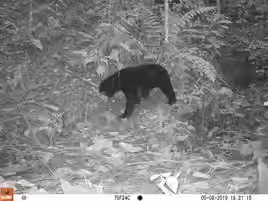
THE LEUSER
ECOSYSTEM
There is only one place left on Earth where Sumatran orangutans, elephants, tigers and rhinoceros coexist together in the wild – the Leuser Ecosystem.
BIODIVERSITY
HOTSPOT.
Hidden within the heart of Sumatra, Indonesia, lies one of the most extraordinary and irreplaceable landscapes on Earth—the Leuser Ecosystem.
Covering 2.6 million hectares across the provinces of Aceh and North Sumatra, this vast rainforest is the only place left on Earth where Sumatran orangutans, tigers, elephants, and rhinoceroses coexist in the wild.
It is a haven for some of Sumatra’s most endangered wildlife, and beyond its megafauna, Leuser is a biodiversity powerhouse, teeming with life found nowhere else.
Over 85% of the remaining Sumatran orangutans call the Leuser Ecosystem home, swinging through its ancient canopy.
This forest is also one of the last refuges for the Sumatran tiger, whose numbers have dwindled due to habitat destruction and poaching.
Even more critically, with fewer than 80 individuals left in the wild, the Sumatran rhinoceros exists mostly within this ecosystem, making it a final hope for the species' survival.
The Sumatran elephant, too, depends on Leuser’s forests for its migratory paths and food sources.
THE FOREST EDGE.
Beyond wildlife, the Leuser Ecosystem plays a crucial role in sustaining millions of people.
Its rivers provide clean drinking water and irrigation for farming communities. The dense rainforest acts as a carbon sink, mitigating climate change by absorbing vast amounts of CO₂, and it's mountains and peatlands prevent natural disasters such as floods and landslides, protecting villages and farmlands.
The Gunung Leuser National Park is a protected area within the Leuser Ecosystem that has its own teams of government employed rangers to protect the forest within.
The forest edge is where communities settle and the interface of significant human-wildlife conflict.
There is increasing pressure on wildlife to find food and safe corridors and they venture out of the forest and into plantations and communities that have settled against the border of the National Park with no buffer zone in between.
Livestock are grazed in oil palm plantations that exist both legally and illegally immediately against the forest border. This is an easy opportunity for Sumatran tigers to take livestock, and they may then be persecuted in retaliation. Sumatran elephants frequent the forest edge as their remaining habitat diminishes, and regularly feed on high-energy crops. Sumatran orangutans come into community gardens to eat durian fruit, an important income source for these poverty-stricken communities, and they too may be the subject of retaliatory attacks.
Sumatran Ranger Project plays a vital role in helping to maintain a safe and productive environment for the people living along the forest edge as well as helping ensure wildlife can pass through safely without negative consequences.






